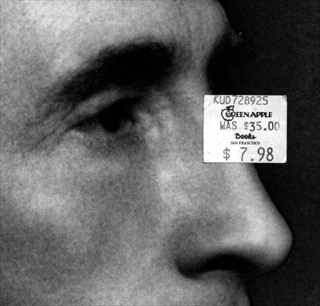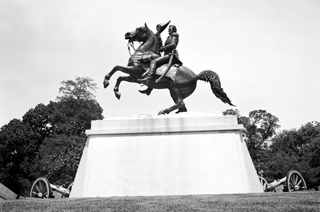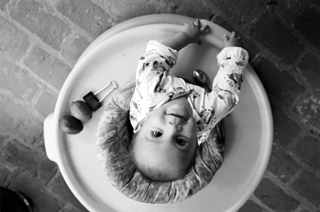- 14 May 1999
- Harvey Littleton's Tree
- I don't have a photograph of Harvey Littleton's tree, the one outside his kitchen window. I remember that it was quite a handsome tree; I spent a lot of time looking at it while I was washing the dishes. I memorized that tree; why would I want to photograph it?
But that was a long time ago, a quarter of a century to be more or less precise. And it's not Harvey Littleton's tree anymore, either; he moved to North Carolina a long time ago.
I made a mistake when I decided not to photograph the tree I memorized; I now can't remember what it looks like.
I made a lot of mistakes when I was young; that's what young people do best. Ignoring my sordid personal affairs, the biggest mistake I made when I was young was to take myself too seriously. The usual mistake, I suppose.
I remember one summer day when I was bored, and thinking too much about Art. I decided that there was no reason to possess negatives that were not of aesthetic value, so I went through all the photographs I'd ever made and put all the "non-art" negatives in a large paper grocery bag. I think I nearly filled it.
I took the bag into the back yard and burned it. (Everyone burned the trash in their back yards back then.) As a result, I lost some of my most valuable photographs. If they weren't valuable in the aesthetic sense, at least I could have used the images of teenage debaucheries to blackmail my friends who are now captains of industry and/or running for office.
Damn damn damn damn damn damn damn!


- 15 May 1999
- Discounting Duchamp
- It's hard to discount Marcel Duchamp at the end of the twentieth century, but not impossible. I, of all people, have empirical proof of this. I bought Calvin Tomkins' biography of Duchamp for $7.98, discounted from the original $35.00.
I haven't read it. It's an awfully thick book. Like so many other consumers, I bought the book for its cover. Who did Dr. Frank N. Furter think he was fooling when he admonished Brad and Janet not to judge a book by its cover, anyway?
So there's Marcel staring nobly into space, but it's not just any Marcel. It's Man Ray's version of Marcel, ever so gently solarized. But here's the beautiful part: Marcel's not staring into space at all! He's looking at the bright, lime Green Apple sticker announcing that he's been discounted.
I can almost hear him chuckle. Almost.

- 16 May 1999
- Unclear Chador Situation
- There's a woman in a black chador; she's black from head to toe and back again. I'm fascinated; I've never seen such a thing before. I mean, I've seen photographs of a woman in a chador before, but seeing her not in the flesh is quite a different thing.
I'm not sure what to make of the situation. The woman is painting text in yellow paint on a green canvas tent. It appears to be a military tent; it has a red cross in a white circle on it; it looks like some sort of field hospital.
But there are a couple of things wrong with this picture. In chador country, you don't see red crosses, you see red crescents. (I hear that the Arabs are still pissed off about the crusades, and I can't say as I blame them.)
The other thing not quite right is that the woman is painting the tent in a small sculpture park. I fear I may be witnessing some bad political art in the making, but I'm not sure. I'm not close enough to read the text.
I'm tempted to photograph the woman, but I resist that urge. If she's an Arab woman, then I wouldn't feel quite right invading her privacy, even though she is doing a public act in a public place. And if she's wearing the chador as a fashion statement, well, who wants a picture of an artist in a chador?

- 17 May 1999
- Rerun Today
- I'm in a new city listening to a new radio station, and there's a program I haven't heard before. It's called Performance Today. I imagine it will be a combination of musicians, comics, actors, and other performers. This is good; I don't get out much, and I'm looking forward to hearing some new work.
It turns out, though, that Performance Today is a misleading title. The show should have been called "Dead Old White Guys' Music Gets Played Yet Again Still More."
Tonight's program promises "new insights into Bach," but it does not deliver them.

- 18 May 1999
- Airborne Wildlife
- Today's stolen idea is to drop endangered species out of airplanes. Anyone can appreciate that dropping a beluga into the ocean from ten thousand meters would make a whale of a splash!
Of course, the damn animal lovers are going to complain; they always do. I'm ready for them.
There are two reasons my plan wouldn't hurt the animals. First, we wouldn't really drop them. Instead, we'd simply take, say, a baby elephant up in a 747. We'd use one of the new 747s with the long-range fuel tanks so we could stay in the air for at least twelve hours.
Then we'd start the fundraising appeals.
Using television broadcasts coupled with massive international phone banks, we'd appeal for funding for, say, a new wildlife sanctuary. If we didn't raise $750,000 by a given deadline, it's Dumbo away! Operators are standing by!
Of course, some people might think that we wouldn't give the baby elephant the old heave-ho. Wrong-o!
We'd push the elephant out of the jet, but we'd have two more jets below--but off-camera--with a safety net stretched between them. The baby elephant would be safely caught, and kept in good shape to fundraise another day.
After we'd successfully demonstrated that we mean business, the millions would roll in. A bit later in the program we could dispense with the 747s altogether and do everything on computer in the studio.
Pushing endangered species out of jets is an idea that can't fail.

- 19 May 1999
- Sisters of The Dragon
- I got an inscrutable email message from "Si-Je and Founder, Sisters of The Dragon." I have no idea who they are or what they do, but no one can deny that the Sisters of The Dragon should not be ignored.


- 20 May 1999
- Decoding Statues
- I was walking through a park in Washington, DC, when I came across a guy giving a presentation to a bunch of schoolchildren about statues of dead military guys. I missed the first part of the talk. When I approached, he was saying something about the dead guy obviously having died in service to his country because the metal horse he's on has one leg in the air.
"And if the horse has two legs in the air, he died in battle. And if the horse is standing on one leg, take a picture of it, because a horse can't stand on one leg."
I guess if the horse has all four metal legs on the pedestal, then the dead guy died in retirement. I don't know what the statues are telling me about those dead white guys, because I don't care how they got that way. That's their business.

- 21 May 1999
- Mrs. Thomas Eakins
- I went to the Hirshhorn Museum in Washington, DC, a few days ago. I liked the first painting I saw. I might have liked it because my fresh eyes were free of viewing fatigue; it was my first time in a museum in almost a year. But I think I liked it because it was a good picture.
The painting shows a handsome, middle-aged woman; it seems obvious to me that the painter was in love with her. I checked the title: Mrs. Thomas Eakins. Mr. Thomas Eakins painted the picture of his wife in 1899. I got a glimpse of one or two people in love from exactly one century ago. Extraordinary!
I saw Mrs. Thomas Eakins again a bit later when I came across Samuel Murray's statue, Full-Length Figure of Mrs. Thomas Eakins. Mrs. Thomas Eakins was a very attractive woman. One of the myriad wonderful benefits of being an artist is that lovely women who might not light a cigarette for an ugly-to-nondescript accountant will partner up for all sorts of wild adventures with an ugly-to-nondescript artist.
But back to the subject at hand, Mrs. Thomas Eakins. A lot changes in a century, including naming conventions. I have a serious problem calling someone Mrs. (Husband's Name). My feeble reference resources didn't mention Ms. Eakins' existence, let alone her first name. What a pity that someone who was clearly an exceptional women is now known only as an artist's wife.

- 22 May 1999
- Photorealism
- I've seen a lot of "photorealism" paintings recently; they confuse me. Why would anyone bother with all the unnecessary work to mimic a camera? After all, cameras make photographs really well. It seems strange to spend weeks with a paintbrush doing what a camera could have done in a thousandth of a second. Of course, photorealistic paintings sell for tens of thousands of dollars more than photorealistic photographs; that may have something to do with it.
The photorealism school of painting reminds me of someone trying to calculate pi to a bazillion decimal places using a pencil and paper when a computer could do the same thing rather more quickly. I'm not going to worry about it too much; making art need not mean making sense.


- 23 May 1999
- Akirno Carl Raychaudhury (snaportrait)
- Akirno is the grandson of a friend of mine.


